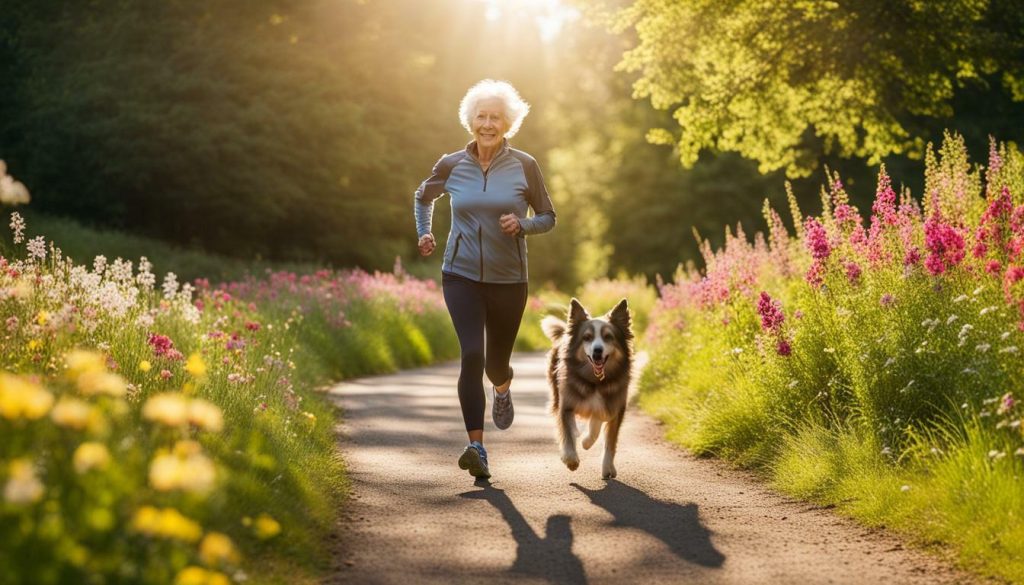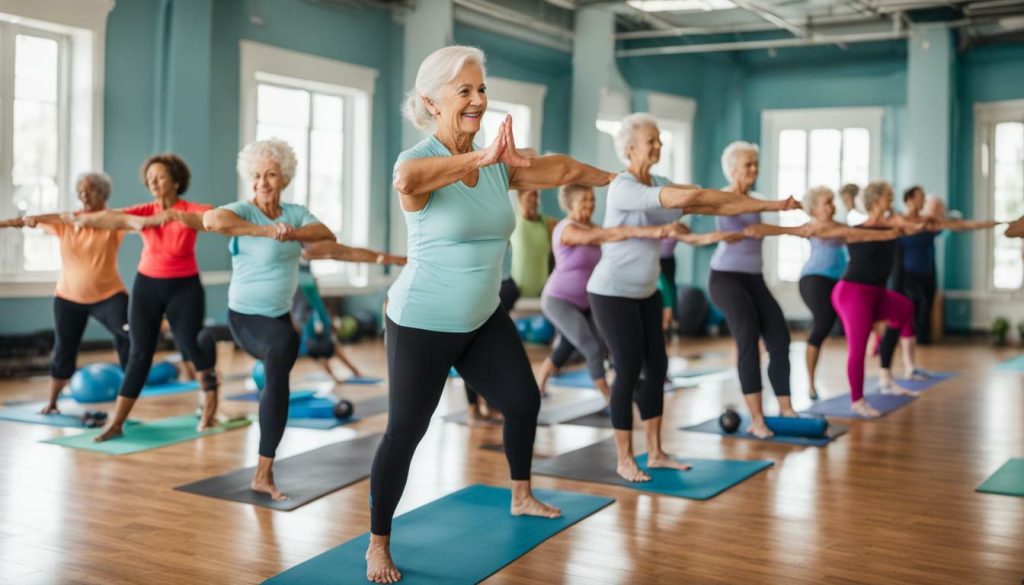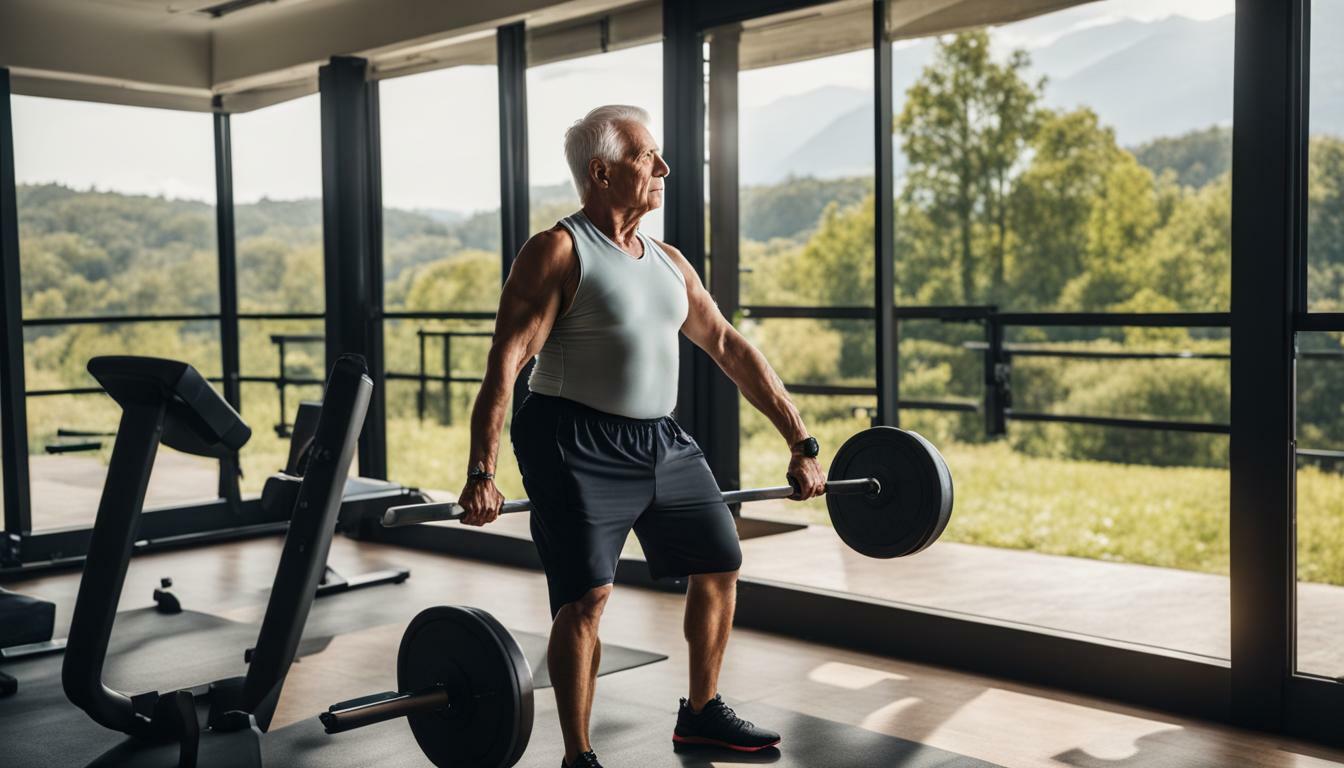Exercise for longevity is one of the best things to pair with healthy eating to reach your golden years. Research suggests that exercise has a greater impact on lifespan than other lifestyle factors.
The optimal amount of exercise varies, but a general guideline is to devote 50% of your exercise time to strength-training and the other 50% to cardio. Strength-training exercises help increase muscle strength, endurance, and bone density, while cardio exercises improve cardiovascular health.
Overall, the key to long-term health and longevity is to find an exercise routine that you enjoy and can consistently incorporate into your lifestyle.
Key Takeaways:
- Exercise plays a crucial role in promoting longevity and overall health.
- Research suggests that exercise has a greater impact on lifespan than other lifestyle factors.
- Aim to devote 50% of exercise time to strength-training and 50% to cardio.
- Strength-training exercises increase muscle strength, endurance, and bone density.
- Cardio exercises improve cardiovascular health.
The Impact of Exercise on Longevity
Research suggests that exercise has a greater impact on lifespan than other lifestyle factors, making it a key component of a long and healthy life. Numerous studies have shown that regular exercise not only improves physical fitness but also positively affects overall health and longevity. Engaging in physical activity has been linked to a reduced risk of chronic diseases such as heart disease, diabetes, and certain types of cancer.
Exercise also plays a vital role in maintaining cognitive function and mental health as we age. It has been shown to enhance memory, concentration, and overall brain function. Regular exercise promotes the release of endorphins, also known as “feel-good” hormones, which can help reduce stress, anxiety, and even symptoms of depression.
When it comes to longevity, finding the right balance between strength training and cardiovascular exercises is essential. Strength training exercises help increase muscle strength, endurance, and bone density, which are crucial for healthy aging.
Examples of strength-training exercises include weight-lifting, push-ups, deadlifts, lunges, planks, bodyweight squats, and burpees. On the other hand, cardio exercises like walking, running, cycling, and swimming improve cardiovascular health, increase endurance, and boost overall fitness.

It’s important to note that the optimal amount of exercise varies from person to person. However, a general guideline is to devote 50% of your exercise time to strength training and the other 50% to cardio. For strength training, aim for at least two sessions per week, focusing on different muscle groups. When it comes to cardio, aim for 80% low-intensity exercises like speed-walking or moderate biking, and 20% high-intensity exercises like running or jumping jacks.
Ultimately, even small amounts of exercise can yield longevity benefits. Incorporating physical activity into your daily routine is key. Experts recommend at least 150 minutes of moderate aerobic activity per week, such as brisk walking or cycling, along with muscle-strengthening activities on two or more days a week.
Additionally, incorporating balance and flexibility exercises into your routine can help maintain mobility and prevent falls, especially in older adults. Spending just 10 minutes a day on stretching and balance exercises can be sufficient.
In conclusion, exercise is a crucial factor in promoting longevity and overall health. By finding an exercise routine that suits your preferences and interests, you can enjoy the many physical and mental benefits it provides. Remember, consistency is key, so make an effort to incorporate exercise into your lifestyle for long-term health and longevity.
Finding the Right Balance: Strength Training and Cardio
The optimal amount of exercise varies, but a general guideline is to devote 50% of your exercise time to strength training and the other 50% to cardio. Both forms of exercise play a crucial role in promoting longevity and overall health.
Strength training exercises help increase muscle strength, endurance, and bone density, which are essential for healthy aging and longevity. Incorporating exercises such as weight-lifting, push-ups, deadlifts, lunges, planks, bodyweight squats, and burpees into your routine can provide significant benefits. These exercises target multiple muscle groups, improving functional strength and reducing the risk of age-related muscle loss. Strength training also stimulates the production of growth factors that promote tissue repair and maintenance.
On the other hand, cardio exercises are vital for improving cardiovascular health and enhancing longevity. Engaging in activities that raise your heart rate, such as speed-walking, moderate biking, running, or jumping jacks, can help strengthen your heart and lungs. Regular cardio workouts increase your aerobic capacity, lower blood pressure, improve blood circulation, and reduce the risk of chronic diseases, including heart disease, diabetes, and certain cancers.
Remember, finding the right balance between strength training and cardio is key. By incorporating both types of exercises into your routine, you can maximize the benefits and enhance longevity. Aim for at least 150 minutes of moderate aerobic activity per week and include two sessions of strength training exercises. Additionally, even shorter bouts of exercise and activities that increase daily steps can have positive effects on health and lifespan.

To help you get started with your longevity exercise routine, here’s a sample workout plan that incorporates both strength training and cardio:
| Strength Training | Cardio |
|---|---|
| 3 sets of 10-12 reps of weight-lifting exercises (e.g., dumbbell curls, bench press) | 30 minutes of speed-walking or moderate biking |
| 3 sets of 10-12 reps of bodyweight exercises (e.g., push-ups, squats) | 5 minutes of high-intensity interval training (e.g., running or jumping jacks) |
| 3 sets of 10-12 reps of resistance band exercises (e.g., lateral raises, seated rows) | 30 minutes of low-intensity steady-state cardio (e.g., swimming or cycling) |
Remember to consult with a healthcare professional before starting any new exercise routine, especially if you have any underlying health conditions.
Strength Training for Longevity
Strength-training exercises are essential for maintaining muscle strength, endurance, and bone density as you age. These exercises not only help you look and feel stronger, but they also play a crucial role in promoting longevity and healthy aging. Incorporating strength training into your exercise routine can significantly improve your overall health and well-being.
When it comes to strength training, it’s important to focus on exercises that target different muscle groups and provide a balanced workout. Weight-lifting, push-ups, deadlifts, lunges, planks, bodyweight squats, and burpees are all effective exercises that can help you build strength and increase muscle mass.
It’s recommended to allocate around 50% of your exercise time to strength training, while dedicating the other 50% to cardiovascular exercises. This balanced approach ensures that you reap the full benefits of both types of exercises. By combining strength training and cardio, you can enhance your cardiovascular health, improve your endurance, and maintain strong muscles and bones.
| Strength Training Exercise | Muscle Group |
|---|---|
| Weight-lifting | Upper body (arms, shoulders, chest) |
| Push-ups | Chest, shoulders, triceps, core |
| Deadlifts | Back, glutes, hamstrings |
| Lunges | Quadriceps, hamstrings, glutes |
| Planks | Core, shoulders |
| Bodyweight squats | Quadriceps, hamstrings, glutes |
| Burpees | Full body |
Including strength training in your longevity workout plan can help you maintain muscle mass, prevent age-related muscle loss, and improve your overall physical performance.
Remember to consult with a fitness professional or trainer to ensure you are performing the exercises correctly and safely. With consistency and dedication, you can experience the numerous benefits of strength training and enjoy a longer, healthier life.

Cardiovascular exercises play a crucial role in improving heart health and extending longevity. Regular aerobic activity helps strengthen the heart muscle and improve blood circulation, reducing the risk of cardiovascular diseases such as heart attack and stroke. Whether it’s jogging, cycling, swimming, or dancing, any exercise that gets your heart rate up and keeps it elevated for an extended period is beneficial for your cardiovascular health.
Research has shown that engaging in cardiovascular exercises can increase life expectancy and enhance overall well-being. These exercises not only contribute to weight management but also improve lung capacity, decrease blood pressure, and boost mood by releasing endorphins, the feel-good hormones.
By incorporating cardio workouts into your routine, you can not only improve your physical health but also reduce the risk of chronic conditions such as obesity, diabetes, and certain types of cancer.

When it comes to cardio exercises, it’s essential to strike a balance between low-intensity and high-intensity workouts. Low-intensity exercises, like brisk walking or moderate biking, are excellent for building endurance and burning calories. Aim to spend at least 80% of your cardio workout time on these activities. High-intensity exercises, on the other hand, such as running or jumping jacks, help improve cardiovascular fitness and boost metabolism. Dedicate about 20% of your cardio session to these higher intensity activities.
By incorporating cardiovascular exercises into your fitness routine, you can support not only your heart health but also enhance your longevity. Remember to consult with your healthcare provider before starting any exercise program, especially if you have any pre-existing medical conditions or concerns about your physical ability.
The Power of Regular Physical Activity
Even small amounts of exercise can yield longevity benefits, making it important to engage in physical activity regularly. Research shows that regular physical activity is associated with a lower risk of chronic conditions such as heart disease, diabetes, and certain types of cancer. It can also help improve mental health, reduce stress, and boost overall well-being.
When it comes to exercise for longevity, consistency is key. Aim for at least 150 minutes of moderate aerobic activity per week, such as brisk walking, swimming, or cycling. This can be broken down into smaller bouts of exercise throughout the week, making it more manageable to fit into your schedule.

In addition to aerobic exercise, strength training is crucial for maintaining muscle mass, strength, and bone density. Include at least two sessions of strength training per week, focusing on exercises that target major muscle groups. These can include weightlifting, push-ups, deadlifts, lunges, planks, bodyweight squats, and burpees.
A Sample Weekly Exercise Routine:
| Day | Activity |
|---|---|
| Monday | 30 minutes of brisk walking |
| Tuesday | Strength training: 3 sets of 10 reps for each exercise |
| Wednesday | 30 minutes of swimming |
| Thursday | Strength training: 3 sets of 10 reps for each exercise |
| Friday | 30 minutes of cycling |
| Saturday | Rest day or flexibility and balance exercises |
| Sunday | 30 minutes of brisk walking |
Remember, it’s essential to listen to your body and consult with a healthcare professional before starting any new exercise routine, especially if you have any underlying health conditions or concerns.
Recommended Exercise Guidelines for Longevity
Experts recommend at least 150 minutes of moderate aerobic activity per week and at least two sessions of strength training per week for optimal longevity benefits. It’s important to find a balance between cardiovascular exercises and strength training to reap the full rewards of exercise.
For cardiovascular exercises, focus on low-intensity activities like speed-walking, moderate biking, or swimming. These exercises should make up about 80% of your cardio routine and provide a steady, sustainable form of exercise.
In addition to low-intensity cardio, incorporate high-intensity exercises like running or jumping jacks into your routine. These should make up the remaining 20% of your cardio workouts and help improve cardiovascular fitness.
When it comes to strength training, engage in exercises that target different muscle groups. Consider including weight-lifting, push-ups, deadlifts, lunges, planks, bodyweight squats, and burpees in your routine. These exercises help increase muscle strength, endurance, and bone density, which are essential for healthy aging and longevity.

| Activity | Duration | Intensity |
|---|---|---|
| Moderate Aerobic Activity | At least 150 minutes per week | Moderate (e.g., brisk walking or cycling) |
| Strength Training | At least two sessions per week | Moderate to high (e.g., weightlifting or bodyweight exercises) |
Remember, even small amounts of exercise can contribute to your overall health and longevity. Incorporating physical activity into your daily routine, such as taking the stairs instead of the elevator or going for short walks during breaks, can make a significant difference. Additionally, don’t forget to incorporate balance and flexibility exercises into your routine, especially if you’re an older adult. Spending just 10 minutes a day on these exercises can help maintain mobility and prevent falls.
Ultimately, the key to long-term health and longevity is to find an exercise routine that you enjoy and can consistently incorporate into your lifestyle. Stay active, prioritize both cardio and strength training, and reap the benefits of living a longer, healthier life.
Balance and Flexibility Training for Healthy Aging
In addition to strength training and cardiovascular exercises, balance and flexibility training are crucial for maintaining mobility and preventing falls as you age. These types of exercises help improve stability, coordination, and range of motion, allowing you to perform daily activities with ease and reducing the risk of injury.
To incorporate balance training into your routine, consider exercises such as standing on one leg, heel-to-toe walk, or yoga poses like tree pose and warrior III. These exercises challenge your body’s ability to maintain equilibrium, enhancing your balance and proprioception. Aim to spend at least 10 minutes a day on balance exercises to reap the benefits.
Flexibility training, on the other hand, involves stretching exercises that lengthen the muscles and improve joint flexibility. Regular stretching can help relieve muscle tension, increase circulation, and improve posture. Some effective flexibility exercises include static stretches, dynamic stretches, and yoga routines. Remember to always warm up before stretching and perform each stretch in a controlled manner without bouncing. Aim to dedicate 10 minutes a day to flexibility exercises.
| Benefits of Balance Training | Benefits of Flexibility Training |
|---|---|
|
|
The Importance of Staying Active
Engaging in a variety of exercise modalities, including balance and flexibility training, can help you lead a healthier and more active lifestyle as you age. It’s essential to find activities that you enjoy and can easily incorporate into your daily routine. Remember that even small amounts of exercise can yield significant longevity benefits, so don’t underestimate the power of taking a walk, practicing yoga, or performing some simple balance exercises.

To promote healthy aging and maintain mobility, it’s important to include balance and flexibility training in your exercise routine. These exercises help improve stability, coordination, range of motion, and posture, reducing the risk of falls and enhancing overall quality of life as you age.
Don’t forget to consult with a healthcare professional before starting any new exercise program, especially if you have any underlying health conditions. So, let’s stay active, incorporate balance and flexibility exercises into our daily lives, and enjoy the numerous benefits they bring!
Incorporating Exercise into Your Lifestyle
To achieve long-term health and longevity, finding an exercise routine that you enjoy and can consistently incorporate into your lifestyle is key. The good news is that you don’t have to spend hours in the gym or force yourself to engage in activities you dislike. By adopting a holistic approach to exercise, you can make it a seamless part of your daily routine and reap the benefits for years to come.
One effective way to incorporate exercise into your lifestyle is by setting realistic goals and creating a schedule. Start by determining your fitness level and identifying activities that align with your interests and abilities. Whether it’s going for a brisk walk, joining a dance class, or practicing yoga, choose activities that you genuinely enjoy. It’s important to remember that exercise should be a source of pleasure, not a chore.
In addition to planned workouts, look for opportunities to integrate physical activity into your daily life. Take the stairs instead of the elevator, walk or bike to nearby destinations, or engage in household chores that get your body moving. Every step counts towards your overall health and longevity.
Summary:
- Find an exercise routine that you enjoy and can consistently incorporate into your lifestyle for long-term health and longevity.
- Set realistic goals and create a schedule that works for you, considering your fitness level and interests.
- Integrate physical activity into your daily life by choosing active transportation, taking the stairs, or engaging in household chores.
| Activity | Frequency | Duration |
|---|---|---|
| Strength training | At least two sessions per week | 30 minutes per session |
| Cardiovascular exercise | 150 minutes per week | 30 minutes per day, 5 days a week |
| Balance and flexibility training | Daily | 10 minutes per day |
“Exercise should be a source of pleasure, not a chore.”

Regular exercise is crucial for promoting longevity, overall health, and enjoying the benefits of a long and active life. Research suggests that exercise has a greater impact on lifespan than other lifestyle factors, making it an essential component of a healthy lifestyle. To maximize the benefits, it is recommended to devote 50% of your exercise time to strength training and the other 50% to cardiovascular exercises.
Strength training exercises, such as weight-lifting, push-ups, lunges, and planks, help increase muscle strength, endurance, and bone density. On the other hand, cardiovascular exercises, such as speed-walking, moderate biking, and running, improve your heart health and overall cardiovascular fitness, contributing to longevity.
Even small amounts of exercise can yield significant benefits, so it’s important to engage in physical activity regularly. Aim for at least 150 minutes of moderate aerobic activity per week and incorporate at least two sessions of strength training.
Furthermore, don’t forget the importance of balance and flexibility training. Spending just 10 minutes a day on exercises that improve your balance and flexibility can help maintain mobility, prevent falls, especially in older adults, and enhance overall well-being.
In conclusion, finding an exercise routine that you enjoy and can consistently incorporate into your lifestyle is key to reaping the long-term health and longevity benefits.
Uncover the future of well-being! Dive into our blog for captivating health and tech insights. Continue the journey to a healthier, tech-driven life with us.
FAQ
Q: How does exercise promote longevity?
A: Exercise has been shown to have a greater impact on lifespan than other lifestyle factors. Regular physical activity helps improve overall health, reduces the risk of chronic diseases, and enhances mental well-being, all of which contribute to longevity.
Q: What is the optimal amount of exercise for longevity?
A: While the optimal amount of exercise varies for each individual, a general guideline is to devote 50% of your exercise time to strength-training exercises and the other 50% to cardio. This combination helps promote muscle strength, endurance, cardiovascular health, and bone density.
Q: What are some examples of strength-training exercises for longevity?
A: Strength-training exercises that can increase muscle strength, endurance, and bone density include weight-lifting, push-ups, deadlifts, lunges, planks, bodyweight squats, and burpees.
Q: Which cardio exercises are beneficial for longevity?
A: For cardiovascular health and longevity, aim for 80% low-intensity exercises such as speed-walking or moderate biking, and 20% high-intensity exercises like running or jumping jacks.
Q: Can even small amounts of exercise have an impact on longevity?
A: Yes, even small amounts of exercise can yield longevity benefits. It’s important to engage in physical activity regularly, and experts recommend at least 150 minutes of moderate aerobic activity per week and at least two sessions of strength training per week.
Q: Are balance and flexibility training important for longevity?
A: Yes, balance and flexibility training are important for maintaining mobility and preventing falls, particularly in older adults. Spending just 10 minutes a day on flexibility and balance exercises can be sufficient to promote healthy aging.
Q: How can I incorporate exercise into my daily routine?
A: To incorporate exercise into your lifestyle, find activities you enjoy and can consistently engage in. Consider walking or biking instead of driving, taking the stairs instead of the elevator, and scheduling regular workout sessions. Every little bit of physical activity counts!
Q: What is the key to long-term health and longevity?
A: The key to long-term health and longevity is finding an exercise routine that you enjoy and can consistently incorporate into your lifestyle. Consistency is key, and even shorter bouts of exercise and activities that increase daily steps can have positive effects on health and lifespan.



